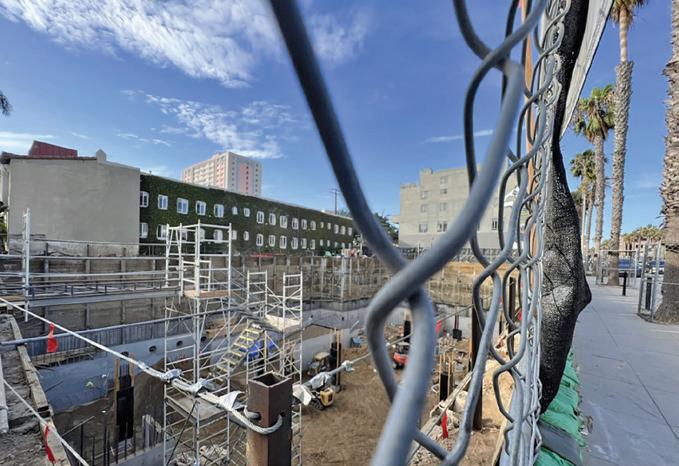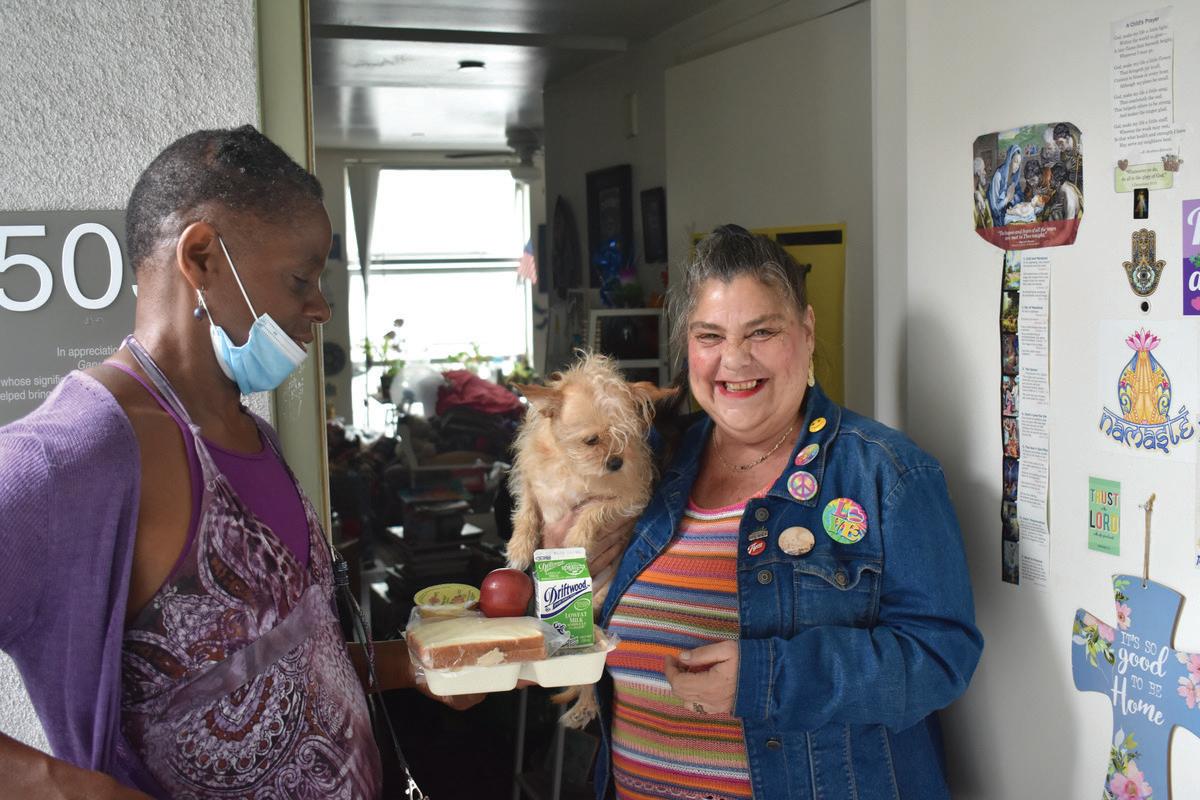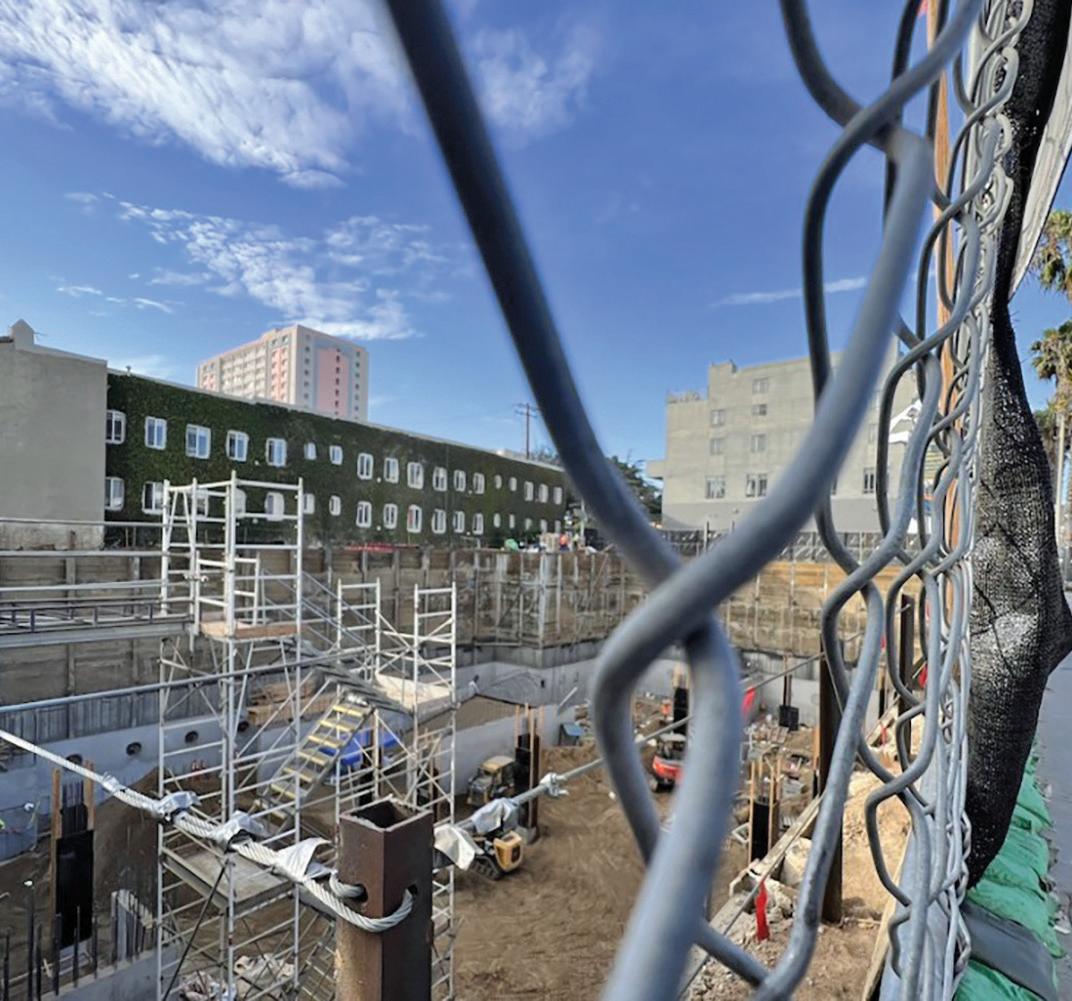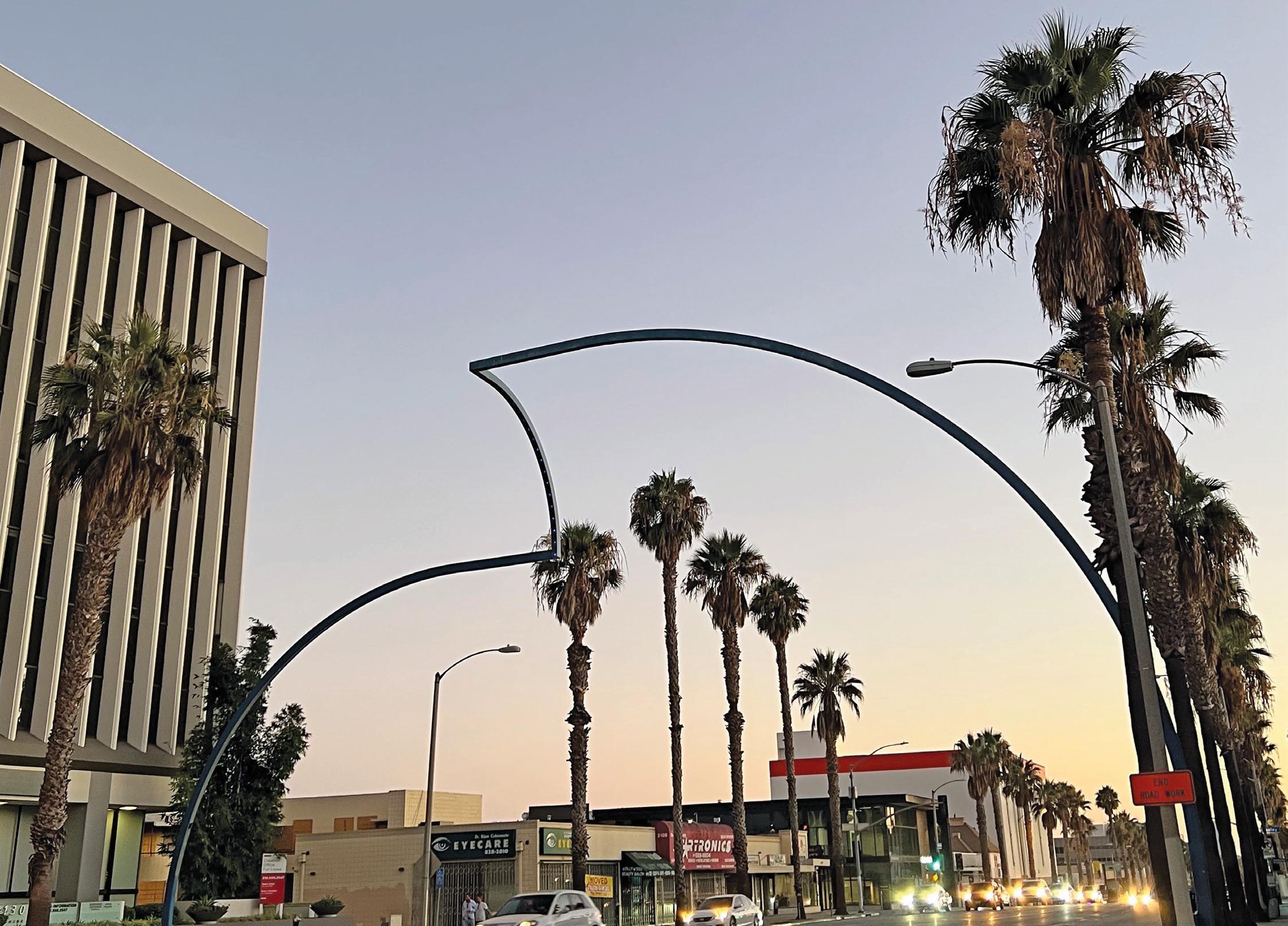Handful of local measures seem poised to pass, Villanueva in danger of losing Sheriff’s race
By Sam CatanzaroCaroline Torosis, Jesse Zwick and Lana Negrete continue to lead in the race for three seats on Santa Monica City Council.





As of 3:35 a.m. Wednesday with 23.2 percent of eligible voters counted, attorney and Rent Control Board Commissione Torosis holds the top spot with 18.91 percent of the vote. Public policy advisor Jesse Zwick has garnered 16.63 percent of the vote in second place while Lana Negrete – a current Councilmember and small business owner – is in third place, collecting 12.48 percent of the vote. Environmental attorney and Planning Commissioner Ellis Raskin, civil engineer Armen Melkonians, and financial analyst Natalya Zernitskaya trail Negrete by 492, 500 and 551 votes respectively for the third City Council seat.
Santa Monica voters seem likely to approve a handful of local measures as well. Measure CS, which would increase overnight taxes for hotels and home shares to raise funds to address homelessness and improve 911 response times, has collected 72 percent of the vote. Measure HMP, which would establish a business tax on every licensed cannabis business, including adult-use nonmedicinal cannabis retailers, seems likely to pass as well, collecting 66 percent of the vote. Measures to expand eligibility on City personnel boards and bolster rent control also seem likely to pass. Measure GS, a transfer tax on properties over $8 million to raise funds for schools, homelessness prevention and affordable housing, could pass as well, with 51 percent of voters casting a yes ballot currently.
Measure SMC is also on the verge of passing. The measure would authorize $375,000,000 in bonds at legal rates, levying 2.5 cents per $100 assessed valuation, raising $23,000,000 annually to improve access to affordable education, provide affordable housing for homeless students, modernize instructional labs and upgrade obsolete vocational classrooms. it needs 55 percent or more of the vote to pass and currently has collected 54.47 percent of votes.

At
much of the Westside – State Senator Bob Hertzberg holds a slim, 1.56 point lead over West Hollywood Councilmember Lindsey Horvath.
At the statewide level, Governor Gavin Newsom holds a comfortable lead over Republican challenger Brian Dahle while at the federal level both Senator Alex Padilla and Congressman Ted Lieu each seem likely to hold onto their seats.
Ancient Wonders – Egypt & Nile River Cruise

February 16, 2023 (10 days)
Includes Cairo City Tour and 4-Night Nile Cruise Aboard Five Star MS Acamar
Tour Rate: $4,999 per person double
MEALS ON WHEELS WEST IS PART OF THE SOLUTION TO HOMELESSNESS
Our Food & Shelter Program Serves the Formerly Unhoused
26% of MOW West's clients are formerly unsheltered. increase in our Food & Shelter clients over the last three years. 78%
April 26, 2023 (10 days)

Featuring Amsterdam & 7 Nights aboard the Amadeus Queen
Tour Rate: $4,895 per person double
Iceland: Land of Fire & Ice
August 13, 2023 (10 days)
Featuring Reykjavík, Thingvellir National Park, Breidafjördur Bay Cruise, Jökulsárlón Glacial Lagoon, and more!

Tour Rate: per person double

For information please call: (310) 394-9871 www.wiseandhealthyaging.org/ international-trips
Food & Shelter promotes stability, health, & wellness, allowing clients to reintegrate into society.
"There's no place like Meals on Wheels West. They are loyal, kind, and compassionate for doing what they do. You can count on them to go the extra way."
Marianne, MOW West Food & Shelter client




















Ice at Santa Monica Grand Reopening Delayed Due to Rain
Opening will now take place November 16
By Sam CatanzaroThe grand reopening for Ice at Santa Monica has been delayed a week due to inclement weather.
Originally scheduled for this Thursday, the reopening will now take place on Wednesday, November 16 from 6-10 p.m. due to rain in the forecast. The grand opening ceremony will include free skating, a live DJ, delicious bites and freebies.
“We are so pleased to offer to our community our unique Winterlit events and programming, and to welcome back Ice at Santa Monica. These events are beloved. DTSM Inc. takes tremendous pride in making our Downtown a special destination for everyone,” said DTSM CEO Andrew Thomas.
The rink will once again be set up at the corner of Fifth Street and Arizona Avenue and will be open from November 16 – January 16, 2023.
The rink’s operating hours will be from noon to 10 p.m. with skate rental and all-day admission for $20.
This marks the first time the rink will be open since the onset of the COVID-19 pandemic. Last year the rink was canceled due to issues with the electrical infrastructure.
Ice at Santa Monica is the Westside’s only skating rink and is expected to generate around $1.3 million in gross revenue this year. It costs the City of Santa Monica and DTSM roughly $1.2 million to produce.
The ice rink is not the only holiday programming DTSM has planned. Tens of thousands of colorful lights, decor and garland will deck the Third Street Promenade, 2nd and 4th Streets, Santa will come to the Promenade on December 1 at 6 p.m. for the annual lighting of the official City of Santa Monica 24-foottall holiday tree. Nightly menorah lightings will celebrate the Festival of Lights during the Hanukkah season from Sunday, December 18 through Sunday, December 25.
Santa Monica Place will also join in on the holiday festivities with a variety of events, photo opportunities and performances to accompany holiday shoppers. From November 19 through December 24, guests can cozy up next to Santa for photos and experience the brand-new Santa House upgraded with sleek, festive décor. The shopping center will welcome the return of its twinkle lights and larger than life holiday decor along with the iconic 50-foot Center Plaza Christmas tree. In December, the popular dancing Beach Belles, Breakfast with Santa, Pet Nights, Menorah Lighting and live holiday DJ sets will also take place.
For more information on holiday happenings in Downtown Santa Monica, visit downtownsm.com/winterlit.

Pali High Student Who Went Missing Returns Home Safely
Andrew Wright’s family says 18-year-old returns home after five days
By Sam CatanzaroAndrew Wright, a senior at Palisades Charter High School, has returned home safely after being reported missing last week in West Los Angeles.


According to the Los Angeles Police Department (LAPD), Wright went missing on October 31 around 6 p.m. on the 1700 block of Federal Avenue, just south of Santa Monica Boulevard.
A large search effort took place, with people sharing photos and flyers both on social media and on streets throughout Los Angeles.
On Saturday, Anna Wright, Andrew’s mother, posted a message on social media announcing her son had returned home.
“I know you all want details but we need to respect Andrew’s privacy at this time. With his permission, this is the update we are willing to give right now. According to Andrew, he left home on 10/31 in an unhealthy state of mind and struggled with suicidal thoughts, sleeping on the street in Downtown L.A. for 5 days. He decided to come home today on his own volition and going forward we will be helping him in any
way we can so that he may get to a place where he can be happier,” reads the post.
“We are SO grateful for how you have all surrounded us with love and support at this time, it shows the goodness in this world.
Andrew saw some of the missing person flyers and knows now that he is cared about by so many people.”





Legal Battle in the Future for Santa Monica Following ‘Builder’s Remedy’ Debacle?

City Council
members Phil Brock, Christine Parra and Oscar de la Torre have put forward an agenda item to address “‘residents’ concerns’
By Dolores QuintanaThe issue of the 16 ‘Builder’s Remedy’ applications that were filed during the time period when Santa Monica’s Housing Element was rejected by the State of California may turn into a legal battle as reported by The Real Deal.com.
Doug Sloan, the Santa Monica city attorney, said, as quoted by The Real Deal.com “We did engage outside counsel. It’s important to realize that, when looking at this builder’s remedy issue and the Housing Element law, the rules were not always very clear, and it was somewhat of a moving target from the state.” during a Santa Monica City Council meeting.

Sloan explained, as quoted by The Real Deal.com “I don’t think over the last 18 months the council or staff could have done anything differently to avoid being where we


are.” in response to a new motion regarding the Builder’s Remedy applications.
City Council members Phil Brock, Christine Parra and Oscar de la Torre have put forward an agenda item to address “‘residents’ concerns’ about the permits and urged the council to “hire appropriate outside legal counsel”

Neither Sloan nor Brock responded to requests for comment on the matter, but during the City Council meeting Brock stated that one Builder’s Remedy application that was automatically approved for a 15 story building was, “beyond the pale” and “an unacceptable bar for the rest of the city.”

Sloan has apparently dropped hints about what the City Council may adopt as a legal strategy in the attempt to squash the Builder’s Remedy applications. The 16 approved applications were submitted between February and October 14 of 2022 while Santa Monica’s Housing Element was not in compliance with state mandates. Sloan plans to argue that the date of compliance should be earlier, starting in early September of 2022 when the City Council sent a letter to the state agency informing them that the new version of Santa Monica’s Housing Element was “substantially in compliance” and if the City Council approved it.

The new version of the Housing Element was accepted by the Santa Monica City Council on October 11 and the approved plan
was certified by the state agency days later.
Sloan said, as quoted by The Real Deal. com, “We will be making a good argument that… that was really the cutoff. And so, some of these builder’s remedy applications we received after that we may not have to treat that way.”
While it is not known if this legal strategy will actually work, the legality of applications that are approved by the Builder’s Remedy process has not been settled in the courts. According to state law, certification happens when the final version of the Housing Element is submitted and Santa Monica’s Housing Element was still in draft form in early September and was revised in the time period between the letter and final adoption of the Element by the Santa Monica City Council.
WSC Communities lawyer Dave Rand said, during an interview, “My hope is that the city is going to be selective — like they’re going to find certain projects unappealing and certain projects ok,” Rand said. “But you have council members who are about slow growth. And they’re putting a lot of pressure on their staff to push back on these projects, and so this is not going to be a cakewalk at all. It’s going to be a fight.” WSC Communities is the company that submitted the most Builder’s Remedy applications in Santa Monica during the noncompliance time period.
This potential legal fight makes the issue
of Builder’s Remedy applications much more high profile than it ever has been and could potentially lead to developers taking advantage of the loophole in other cities that have not had their Housing Elements approved by the state agency. Over 100 cities in Southern California have Housing Elements that have been rejected including the cities of Beverly Hills and West Hollywood.
Not everyone in Santa Monica is against these Builder’s Remedy projects, as quoted by The Real Deal.com, a resident who was in favor of these projects wrote as a comment to the agenda item, “I write to urge you to embrace Builder’s Remedy projects. Santa Monica needs more homes and affordable homes, not wasteful litigation!”
Westside Food Bank Facing an Egg Emergency
Organization to cut egg purchases by 50 percent
Westside Food Bank (WSFB) is cutting its egg purchases by 20 percent this month and 50 percent in December due to inflation and the avian flu outbreak.




The cost of eggs has tripled over the past several months, forcing WSFB to make tough decisions. WSFB spends about $50,000 monthly on eggs. To prevent a 50 percent cut in egg purchases, WSFB will need to raise $25,000 a month to meet current prices. WSFB will also be switching from a weekly egg distribution to giving out eggs every other week.
According to the food bank, right now, it can pay $30,000 to get 22 pallets of mixed food items, like tuna, rice, beans and other vital staples, while the same price tag would only get 12 pallets of eggs.

Eggs are one of the food bank’s most popular items.
“This product decrease will hurt the families we serve as we enter the holiday season,” WSFB said.
“We really don’t want to have to cut our purchases because we know families rely on these eggs,” Westside Food Bank President and CEO Genevieve Riutort added. “They want to make scrambled eggs for breakfast, pancakes, protein smoothies and all the different ways people use eggs.”


Without additional support, WSFB will have to pivot to less expensive protein sources. It encourages members of the community to help provide nutritious food for people in need by donating at wsfb.org/donatenow.
For more information, contact Kaitlyn Little at kaitlyn@wsfb.org or (424) 387-3661.
Founded in 1981 by the Westside
Ecumenical Council — a coalition of Westside social service agencies — Westside Food Bank is an independent, non-governmental, 501(c)(3) nonprofit organization, providing food for more than 112,000 households, representing more than 332,000 individuals, on the Westside. This food goes to families with children, seniors, people experiencing homelessness, veterans, college students and differently-abled people.
“Our mission is to end hunger in our communities by providing access to free, nutritious food through food acquisition and distribution, and by engaging the community and advocating for a strong food assistance network. WSFB partners with more than 65 social service agency programs to distribute 4.7 million pounds of food annually,” WSFB says. “The majority of our food goes to housed people who need help to afford groceries. WSFB’s food also allows low-income households to apply their limited funds to housing, childcare, healthcare and other basic needs.”
Such programs include food pantries, preschool/after-school programs, domestic violence shelters, senior citizen meal and grocery delivery programs, bridge housing facilities and more.
Santa Monica Police Activities League Raises Over $18,000 at Spooktacular Halloween Event
Fundraiser provides free enrichment classes and activities to vulnerable youth in Santa Monica
Santa Monica Police Activities League (PAL) hosted its annual Halloween Spooktacular for the community with food and fun while raising over $18,000 for youth programs at the PAL Youth Center in Santa Monica on October 31.
Santa Monica city staff and volunteers transformed the center to feature a mummy’s tomb, a scary circus, graveyard and a haunted maze. Enthusiasm was high for the Halloween haunt as a long line started as early as 4:30 p.m. with the line finally subsiding just after 7:30 p.m. The PAL Halloween Spooktacular was from 5-8 p.m.
While inside the PAL Spooktacular,
hundreds of youth and their families enjoyed the decorated rooms filled with candy, carnival games, arts and crafts, and a photo-booth to receive memorable keepsakes of the event.
Many grateful families shared their sentiments in person as well as on social media. One comment on PAL’s Facebook page from Yaminah Jones stated, “My kids had a ball!”
“Special thanks to Police Chief Ramon Batista and the Police and Fire Departments for their support,” said Eula Fritz, Director at Santa Monica Police Activities League. “In addition, special thanks to the many local businesses, PAL Board members and individuals who sponsored PAL’s Spooktacular as well as a heartfelt thanks to the city staff who worked tirelessly to ensure a fun and safe place for youth to be on Halloween night.”
The PAL Spooktacular Halloween event had a variety of sponsors at different levels. “Spooktacular” was open to all youth and their families.
Act 2 – Matthew Lopez’s Extraordinary Epic “The Inheritance” at the Geffen



CENTER STAGE
The ACT 1 Recap: Under Mike Donohue’s exquisite direction of a sterling cast, Matthew López’s 6 hour and 25 minute sprawling, award-winning “The Inheritance” made its West Coast premiere at the Geffen Playhouse. The following will re-acquaint you with the principal actors, some of whom created two different characters: Bill Brochtrup plays both the E.M. Forster character of Morgan and Walter Poole; Juan Castano characterizes Toby Darling, author and playwright living with his partner Eric Glass, the lynchpin and third-person narrator of the unfolding action wonderfully portrayed by Adam Kantor.
Bradley James Tejeda plays Adam, an aspiring actor with whom Toby falls in love, as well as Leo, a down-and-out sex worker, and finally a most talented Tuc Watkins plays Henry Wilcox, Walter’s wealthy Republican husband for 36 years. We were also introduced to the excellent ensemble, or something akin to a Greek chorus, whose actions and reactions contribute to this riveting play.
ACT 2: The break-up that Toby instigated between he and Eric has more positive results for Eric than for his former partner
who seems embarked upon a self-destructive path. While Toby is immersed in his drug and alcohol downward spiral, while on Fire Island he encourages 19-year-old Leo to have sex with countless men in one evening. The orgies are cleverly staged in a highly-stylized suggestive format, nicely enhanced by Josh Epstein’s lighting. In the meantime, Eric convinces Henry that he would like to see the Upstate New York house and eventually he obliges him. A new character is Tantoo Cardinal’s Margaret Avery. Born in the south, she has been the housekeeper at this home that eventually welcomed hundreds of AIDS infected men who came there to die. In a touching monologue, she retells her story about she and her young son Michael, who came out of the closet. Unable to cope with his truth, she lost contact with him and it wasn’t until years later that they reunited when he contracted AIDS and came to the house where she and Walter took care of him until he died at age 25. Margaret remains guilt ridden that so many years were lost but consoles herself that she was devoted to him during the last year of his life. Subsequently, along with Walter, she looked after hundreds of men stricken with this deadly disease. This is a tearful moment in the play as this excellent actor tells her story. In a lighter moment one of the characters quips, “Hell is better than South
Carolina.” In the meantime, Eric is not happy with his husband Henry who makes it very clear that he is not interested in any physical intimacy but assures Eric that he’s free to find fulfillment outside of the marriage. This is in sharp contrast with when Henry happily proposed saying, “You are the author of my recent smiles.” There are poignant moments such as when two actors play the young Henry and Walter meeting for the first time and how they immediately embraced each other. Walter eventually took up residence in his husband’s townhouse in the West Village, subsequently moving into the same building as Toby and
Eric which is how Eric and Walter become friends, eventually leading to meeting Henry. Eric’s new, older friend shares, “I learned how to f…ck when I was 14, but never knew what love was,” adding, “To fall in love is to have heartbreak.” There are delicious one-liners such as Henry defending being a Republican.
“Why shouldn’t I be a Republican?” “Because you’re gay!” This act is an outlet for opinions and discussions of myriad pressing social and political issues affecting the gay community and was well within the context of the action. Why not touch on subjects germane to their continued survival. Filled with remorse over breaking up with Eric, Toby pleads with him to take him back but at this point, he is in love with Henry and is about to get married. Eventually, Eric, despite never having to worry about money again, is unhappy with the sexless marriage and wants out. After visiting the White Plains house again, Eric has an epiphany and wants to turn the house, where so many men died, into a place where men could continue living. Still in a selfdestructive spiral, but trying to find his way out, Toby heads home to Alabama where he remembers being called a faggot in school but didn’t even know what that meant. Getting clearheaded, and understanding his inability to receive and give love, he resolves to write a truly autobiographical play which upon completion, his agent thinks is kind of long.
(An in-joke reference to the length of “The Inheritance.”) Ready to sign the divorce papers, Eric asks his soon to be his “Ex” to please give him the house and as in “Howards End,” the property reverts back to the one for whom it was originally intended.
Do bear in mind that despite the theatrical exploration of heavy subjects López illuminates, his exquisite writing is sprinkled both with pathos and laughter throughout the play, especially following a particularly heavy scene so there is timely comic relief. Sometimes your tears are ready to fall but comic relief saves you from digging out those tissues.
ACT 2: The break-up that Toby instigated between he and Eric has more positive results for Eric than for his former partner who seems embarked upon a self-destructive
path. While Toby is immersed in his drug and alcohol downward spiral, while on Fire Island he encourages 19-year-old Leo to have sex with countless men in one evening. The orgies are cleverly staged in a highly-stylized suggestive format, nicely enhanced by Josh Epstein’s lighting. In the meantime, Eric convinces Henry that he would like to see the Upstate New York house and eventually he obliges him. A new character is Tantoo Cardinal’s Margaret Avery. Born in the south, she has been the housekeeper at this home that eventually welcomed hundreds of AIDS infected men who came there to die. In a touching monologue, she retells her story about she and her young son Michael, who came out of the closet. Unable to cope with his truth, she lost contact with him and it wasn’t until years later that they reunited when he contracted AIDS and came to the house where she and Walter took care of him until he died at age 25. Margaret remains guilt ridden that so many years were lost but consoles herself that she was devoted to him during the last year of his life. Subsequently, along with Walter, she looked after hundreds of men stricken with this deadly disease. This is a tearful moment in the play as this excellent actor tells her story. In a lighter moment one of the characters quips, “Hell is better than South Carolina.” In the meantime, Eric is not happy with his husband Henry who makes it very clear that he is not interested in any physical intimacy but assures Eric that he’s free to find fulfillment outside of the marriage. This
is in sharp contrast with when Henry happily proposed saying, “You are the author of my recent smiles.” There are poignant moments such as when two actors play the young Henry and Walter meeting for the first time and how they immediately embraced each other. Walter eventually took up residence in his husband’s townhouse in the West Village, subsequently moving into the same building as Toby and Eric which is how Eric and Walter become friends, eventually leading to meeting Henry. Eric’s new, older friend shares, “I learned how to f…ck when I was 14, but never knew what love was,” adding, “To fall in love is to have heartbreak.” There are delicious one-liners such as Henry defending being a Republican.
“Why shouldn’t I be a Republican?” “Because you’re gay!” This act is an outlet for opinions and discussions of myriad pressing social and political issues affecting the gay community and was well within the context of the action. Why not touch on subjects germane to their continued survival. Filled with remorse over breaking up with Eric, Toby pleads with him to take him back but at this point, he is in love with Henry and is about to get married. Eventually, Eric, despite never having to worry about money again, is unhappy with the sexless marriage and wants out. After visiting the White Plains house again, Eric has an epiphany and wants to turn the house, where so many men died, into a place where men could continue living. Still in a selfdestructive spiral, but trying to find his way out, Toby heads home to Alabama where he remembers being called a faggot in school but didn’t even know what that meant. Getting
clearheaded, and understanding his inability to receive and give love, he resolves to write a truly autobiographical play which upon completion, his agent thinks is kind of long. (An in-joke reference to the length of “The Inheritance.”) Ready to sign the divorce papers, Eric asks his soon to be his “Ex” to please give him the house and as in “Howards End,” the property reverts back to the one for whom it was originally intended.
Do bear in mind that despite the theatrical exploration of heavy subjects López illuminates, his exquisite writing is sprinkled both with pathos and laughter throughout the play, especially following a particularly heavy scene so there is timely comic relief. Sometimes your tears are ready to fall but comic relief saves you from digging out those tissues.
‘THE INHERITANCE” Gil Cates Theatre
The Geffen Playhouse

10886 Le Conte Avenue
Los Angeles, CA 90024
Run:
Tuesday – Friday: 8:00pm
Saturday: & Sunday: 1:00pm & 7:00pm
Closing: Sunday, November 27, 2022
Running Time:
PART 1: 3 hours and 10 minutes, including two intermissions.
PART 2: 3 hours and 15 minutes, including one intermission and a brief pause.
Tickets: $39 – $129 310.208.2028 or www.geffenplayhouse.org




ADDITIONAL PRODUCTION TEAM
Costume Designer: Sara Ryung Clement
Sound Designer: Veronika Vorel
Composer: Paul Englishby
Santa Monica Housing Development: Poison Pills, Bad Data and the Blame Game
SMa.r.t.
Prior councils have made longterm decisions that have locked the city into an extraordinarily fixed path, the consequences of which are only now becoming apparent to all stakeholders. In business, a loosely analogous strategy is called a “Poison Pill.”
Poison Pills are generally used to prevent changes. The Council’s decisions made in 2019 and 2020 in reaction to the State’s unchallenged 9,000 housing unit demands have severely constrained Santa Monica’s ability to chart a balanced, realistic and equitable path forward. And, that was the point of those decisions. They were designed to be a Poison Pill.
The prior Council’s key policy response was passive acquiescence to the 9,000 unit allocation and to then let the clock run out on the appeals and objections period, locking all future councils into a straightjacketed liability from which extraction will be very difficult.
Only now are the outcomes of those decisions outcomes being felt. The 500+ unit Gelson’s project and the tentative 4,000-unit Builder’s Remedy projects are only the first, but not the last, examples of the consequences of the legacy Poison Pill decisions.
The Blame Game
Ironically in this election cycle, the groups that have long advocated for this level of development have sought to shift responsibility for city shape-shifting outcomes that they support… to the current Council. Meanwhile, they are arguing vociferously against any opposition to these projects.
According to this line of reasoning, the principal point of culpability by the current Council was its submission of an initial Housing Element to the State back in October of 2021 that was rejected in February of this year. Apparently, the current Council had the temerity to seek balance in submitting a Housing Element that did not disrupt potentially every neighborhood in the city to accommodate the absurd 8,895-unit mandate from the state. In the 197 jurisdictions in the area managed by Southern California Association of Governments (SCAG), Santa Monica ranked #5 in allocated unit density per square mile.
According to the densification-at-any-price advocates, the Council should have simply steamrolled every neighborhood to the extent necessary to create a plan that would have been accepted by the State on initial submission. This would then have eliminated the period of non-compliance that gave developers a window to submit the Density Bonus projects.
Was Santa Monica’s Housing Element rejection an outlier, with the city rightfully singled out for punishment?
Santa Monica was far from unique in the state’s rejection of its initial Housing Element (HE). Out of the 197 SCAG jurisdictions, only six adopted HEs that the state found to be compliant on initial submission. This represented a regional HE submission failure rate of 97%.
The scale of submission failure parallels the unprecedented scale of increase in State mandates on local jurisdictions compared to prior decades of planning. In Santa Monica, the current (6th Cycle) requirement of 8,895 units is at least 5.3x any prior State mandate for the city. The immediately preceding (5th) cycle Santa Monica mandate was 1,674 units.
But we are told that there really was no basis to challenge the State mandate numbers. We are told that they were rigorously developed, within an objective process.
Is that narrative correct? The evidence indicates that it is not. And, if these numbers were not rigorously developed, then on what basis could the prior council objected?
Reversing the decades-old jobshousing regional relationship without any grounded underlying rationale, comprehensive plan or defined benefit(s) justifying such upheaval should have been Red Flag #1.
How could such a radical upscaling of housing requirements, during a period of declining state population, be relevant on a city-by-city basis? Housing’s regional nature
is even captured in the name of the process… the Regional Housing Needs Allocation (RHNA). While we would like to live where we work, we work where we can find the jobs we want and we change jobs based on how we can best advance our careers. Housing simply needs to be approximate. And, according to the US Labor department, the types of jobs associated with hospitality, which is significant in Santa Monica, have the highest turnover, with an average tenure of only 1.6 years.
In addition, with Santa Monica’s 70% affordable housing requirement imbedded in the 8,895-unit mandate, the expectation would be that this regional issue that would result in Los Angeles ringing Santa Monica with affordable housing. Los Angeles has located its major affordable housing overlay 20 miles away in the Valley.
The demonstration of overwhelming subjectivity should have been Red Flag #2.
The clearest evidence that the process was prone to high degrees of subjectivity and manipulation, and therefore lobbyist influence, was during the drafting process for the latest allocations.
In the span of 4 weeks, from October 2, 2019 to November 4, 2019, the allocation to Santa Monica was almost doubled, from 4,829 units to 9,058 units, an increase of 4,229 units (88%). This was part of larger shift of unit allocations across various

jurisdictions, removing units from affordable areas of Southern California and locating them in more expensive developed areas. While this starkly acknowledged the regional aspect of housing, no objective, disciplined, data-driven process would have created such drastic outcome changes in such a short amount of time.
Of course, this massive change was not the result of such a process. It was the direct result of lobbying by Abundant Housing LA (AHLA) via a legal letter to SCAG on October 11, 2019 “urging” SCAG to “…adopt a new methodology without “local inputs” that is compliant and achieves the stated goal of achieving socioeconomic equity with special attention to the needs of lower-income residents.” Apparently, all the modelling and analysis that had been completed by SCAG did not meet SCAG’s own objectives.
But the influence did not end there. At the December 10, 2019 Santa Monica Council meeting, the AHLA director informed the City councilmembers that, should the Council oppose the draft 9,058 allocation, AHLA would push SCAG to assign to Santa Monica a total of 14,155 units, justified by a different spreadsheet modeling exercise done in conjunction with a representative of UCLA’s Luskin School of Public Affairs. As everyone who builds models knows, models
SMa.r.t. Column, from
10
can be constructed to generate any desired outcome.
The complete absence of any outcomes, other than building units, should have been Red Flag #3.
Interestingly, despite all the discussions of unit allocations, models and mandates, there was no indication of any expected outcomes… other than building “units.” If the targets were met, were we done? How much should we see affordability increase? What was the cost of the regionally-driven affordable housing allocation to Santa Monica, and who should bear that cost? What level of rent and house purchase price moderation should be expected from overturning decades of city planning? What level of added congestion would all this development create? What increase in services would this require and how was that going to be paid for? And, most importantly, was the tradeoff worth it the outcomes?
Complete inadequacy of basic data used by SCAG should have been Red Flag #4.
But if AHLA could get into modelling minutia, why did the City not do similar levels of due diligence to satisfy itself (and the residents it represents) that it was signing up for equitable and well thought out requirement that required radically transforming the entire City?
But, if the City wanted to conduct such a due diligence audit, where would it start?
Helpfully, SCAG included the detailed allocation Excel models as publicly available materials contemporaneously with the discussions. These models had the allocation parameters and appendices listing all the data sources.
Had the city done its homework, it would have discovered that the model included 453 data points of which 319 (70%) were sourced from the American Community Survey (ACS), an annual Census department sampling exercise. Some of these estimates were from the 2012-2016 period (up to 10 years old).
In addition to the data being stale, a slight bit of online research would have uncovered a 2014 analysis of ACS accuracy by the National Library of Medicine (NLM), a division of the National Institutes of Health. The NLM concluded that this data was highly flawed, beginning with the fact that response
rates for the survey were around 65% around the time of the analysis. In addition, the report noted that:
“…the amount of uncertainty in the ACS has far exceeded the United States Census Bureau’s (USCB hereinafter) expectations.”
“…the ACS margins of error are so large that for many variables at the census tract and block group scales the estimates fail to meet even the loosest standards of data quality.”
“…ACS small area estimates are plagued by attribute uncertainty. For some variables the uncertainty (margin of error) is so large that the data are difficult to use.”
Interestingly, the ACS data was (and is) used in all the city’s housing analyses and was the sole underlying source of data supporting Measure GS. None of it has been sanity-checked to any actual available realworld data in the city.
The reliance on an inclusionary strategy to generate affordable housing production in the absence of any State funding should have been Red Flag #5
The inclusionary approach, combined with the minimal required inclusionary rates (Gelson’s is 10%) results in massive market rate development far beyond the amount included in the 8,895-unit mandate. A 20% inclusionary rate on all projects would generate total production exceeding 30,000 units, making clear that market rate development was the real objective. The final approved Housing Element contains capacity for 13,600 units.
The scale of funding requirements for these subjectively-defined affordable targets runs into the multiple billions of dollars, expected in an eight-year RHNA timeframe. Since there are no fixed objectives, there are no fixed terminal quantities since there will be endless RHNA cycles after the current 6th Cycle ends in 2029.
If the unsupported state mandated unit assumptions are not challenged, Measure GS may be only the beginning, not the end. With taxes used exclusively for production, additional revenues will have to be found to fund increased services demand and open space maintenance. And, increased congestion and attendant pollution cannot be funded away.
The fallacy of the entire unrealistic transit assumptions should have been Red Flag #6.
Had staff been inclined to look at the allocation methodology, they would have
FICTITIOUS BUSINESS NAME STATEMENT
found that 7,902 units (87% of the draft total 9,058) were based on relocating existing residents of Southern California (“existing need”) to Santa Monica. This was based solely on the presence of “high quality transit areas (HQTA).” HQTAs are defined by the state as “…a walkable transit village or corridor, within one. half-mile of a wellserviced transit stop or a transit corridor with 15-minute or better service.”
Staff would have had difficulty assessing the basic transit bus route utilization within the city since neither unique users nor measures of actual route miles within the city boundaries are maintained.
If staff had used the LA’s Metro Bus line’s 2019 strategic plan as a proxy for service performance targeting, it would have referenced Metro’s goal of “…no more than 2.5x slower than driving.” The need for timely transit for providing job (or multiple job) access across transit lines would clearly not be supported.
Another available data proxy is the BBB’s MODE program in place since 2017, where Lyft is contracted to provide lastmile connectivity for the disabled and for seniors. This limited service is, of course, acknowledgement that bus service is not adequate for large segments of the population, including families with young children and ongoing shopping requirements.
Missed Opportunities, by Design
The prior Council did not task the staff with a fact-finding role to audit the proposed allocations to the city. And, through the thousands of pages of staff output on the topic, none of these fundamental issues were raised.
Had due diligence been performed based on these six red flags, Santa Monica would have had a solid basis for coalition with other cities and negotiation with the state. Santa Monica’s stature would have garnered significant attention and support across the region. It could have demanded to know what outcomes, besides building units, the state’s programs were supposed to deliver, and demand that those outcomes be justified.
Instead, the City chose to commit the community to the absurd housing unit deliverables, with no idea of the costs or tradeoffs. And the city staff defaulted into the role of state enforcer, which continues to this day.
Managing the Aftermath
The current Council, in trying to ameliorate
SUPERIOR COURT
OF CALIFORNIA COUNTY OF LOS ANGELES ORDER TO SHOW CAUSE
The court orders that all persons interested in this matter appear before this court at the hearing indicated below to show cause, if any, why the petition for change of name should not be granted. Any person objecting to the name changes described above must file a written objection that includes the reasons for the objection at least two court days before the matter is scheduled to be heard and must appear at the hearing to show cause why the petition should not be granted. If no written objection is timely filed, the court may grant the petition without a hearing.
NOTICE OF HEARING: Date: 01/03/23 | Time: 8:30AM | Dept: F51
A copy of this ORDER to SHOW CAUSE shall be published at least once a week for four successive weeks prior to the date set for hearing on the petition in the following newspaper of general circulation, printed in this county:
SANTA MONICA MIRROR | Dated: November 03, 2022
Judge Lawrence Cho Published: 11/04/2022, 11/11/22, 11/18/2022, and 11/25/2022
the side effects of these purposely negligent legacy decisions, will invariably test and discover the real limits of the state process, if for no other reason than the specifics of the applicable law are not settled in many areas, including Builder’s Remedy. Moreover, the entire idea that cities can be punished by the State for something they are not in the business of doing, which is building housing, will be tested. Finally, the abject political nature of the haphazard state RHNA construct, devoid of any fundamental economic rationale, is at high risk of imploding across the state over time.
The current situation we find ourselves in reflects the decisions of a staff and a prior Council that have been either unprepared or unequipped (or both) to manage the increasingly complex and rapidly evolving relationship with the State. The State’s only goal was to abolish local development control and to appear to be doing something about escalating housing costs, which reflect multiple local and global economic issues unrelated to a simple supply strategy.
Translation of this open-ended politicallydriven policy agenda into actual policy tools has revealed a host of expedient short cuts and subjective decisions that, taken as a whole, severely compromise the integrity of the entire narrative.
Complacency and passive acquiescence of these highly flawed “mandates” can only guarantee significant dislocation within the city with no benefit.
Going forward, the resident and commercial stakeholders in this city will need to become much more vocal about demanding accountability from both elected and professional staff to serve the equitable interests of the city’s resident and business stakeholders.
By S.M.a.r.t Santa Monica Architects for a Responsible Tomorrow
Thane Roberts, Architect, Robert H. Taylor AIA, Ron Goldman FAIA, Architect, Dan Jansenson, Architect & Building and Fire-Life Safety Commission, Samuel Tolkin Architect & Planning Commissioner, Mario Fonda-Bonardi AIA & Planning Commissioner, Marc Verville
M.B.A, CPA (Inactive), Michael Jolly, AIR-CRE.
FICTITIOUS BUSINESS NAME STATEMENT FILE NUMBER: 202240351 ORIGINAL FILING This statement was filed with the County Clerk of LOS ANGELES ON 11/03/2022. The following person (persons) is (are) doing business as 1. BA Collective. The full name of registrant(s) is/ are: Cory Taylor Architects Inc., 2740 Main St., Santa Monica, Ca. 90405. This business is conducted by A Limited Liability Partnership. The registrant commenced to transact business under the fictitious business name or names listed above on N/A. I declare that all information in this statement is true and correct. (A registrant who declares as true information which he or she knows to be false is guilty of a crime). Signed Amin Ajani. This Statement was filed with the County Clerk of LOS ANGELES County on November 03, 2022. NOTICE: IN ACCORDANCE WITH SUBDIVISION (a) OF SECTION 17920, A FICTITIOUS NAME STATEMENT GENERALLY












